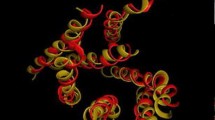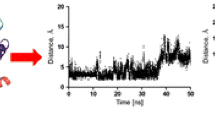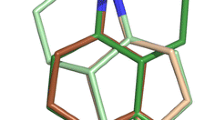Abstract
Homology model structures of the dopamine D2 receptor (D2R) were generated starting from the active and inactive states of \(\upbeta \)2-adrenergic crystal structure templates. To the best of our knowledge, the active conformation of D2R was modeled for the first time in this study. The homology models are built and refined using MODELLER and ROSETTA programs. Top-ranked models have been validated with ligand docking simulations and in silico Alanine-scanning mutagenesis studies. The derived extra-cellular loop region of the protein models is directed toward the binding site cavity which is often involved in ligand binding. The binding sites of protein models were refined using induced fit docking to enable the side-chain refinement during ligand docking simulations. The derived models were then tested using molecular modeling techniques on several marketed drugs for schizophrenia. Alanine-scanning mutagenesis and molecular docking studies gave similar results for marketed drugs tested. We believe that these new D2 receptor models will be very useful for a better understanding of the mechanisms of action of drugs to be targeted to the binding sites of D2Rs and they will contribute significantly to drug design studies involving G-protein-coupled receptors in the future.









Similar content being viewed by others
References
Römpler H, Stäubert C, Thor D, Schulz A, Hofreiter M, Schöneberg T (2007) G protein-coupled time travel: evolutionary aspects of GPCR research. Mol Interv 7:17–25. doi:10.1124/mi.7.1.5
Congreve M, Marshall F (2010) The impact of GPCR structures on pharmacology and structure-based drug design. Br J Pharmacol 159:986–996. doi:10.1111/j.1476-5381.2009.00476.x
Overington JP, Al-Lazikani B, Hopkins AL (2006) How many drug targets are there? Nat Rev Drug Discov 5:993–996. doi:10.1038/nrd2199
Lagerström MC, Schiöth HB (2008) Structural diversity of G protein-coupled receptors and significance for drug discovery. Nat Rev Drug Discov 7:339–357. doi:10.1038/nrd2592
Rasmussen SGF, DeVree BT, Zou Y, Kruse AC, Chung KY, Kobilka TS, Thian FS, Chae PS, Pardon E, Calinski D, Mathiesen JM, Shah ST, Lyons JA, Caffrey M, Gellman SH, Steyaert J, Skiniotis G, Weis WI, Sunahara RK, Kobilka BK (2011) Crystal structure of the \(\upbeta \)2 adrenergic receptor-Gs protein complex. Nature 477:549–555. doi:10.1038/nature10361
Jaakola V-P, Griffith MT, Hanson MA, Cherezov V, Chien EY, Lane JR, Ijzerman AP, Stevens RC (2008) The 2.6 angstrom crystal structure of a human A2A adenosine receptor bound to an antagonist. Science 322:1211–1217. doi:10.1126/science.1164772
Haga K, Kruse AC, Asada H, Yurugi-Kobayashi T, Shiroishi M, Zhang C, Weis WI, Okada T, Kobilka BK, Haga T, Kobayashi T (2012) Structure of the human M2 muscarinic acetylcholine receptor bound to an antagonist. Nature 482:547–551. doi:10.1038/nature10753
Park JH, Scheerer P, Hofmann KP, Choe HW, Ernst OP (2008) Crystal structure of the ligand-free G-protein-coupled receptor opsin. Nature 454:183–187. doi:10.1038/nature07063
Scheerer P, Park JH, Hildebrand PW, Kim YJ, Krauss N, Choe HW, Hofmann KP, Ernst OP (2008) Crystal structure of opsin in its G-protein-interacting conformation. Nature 455:497–502. doi:10.1038/nature07330
Jackson DM, Westlind-Danielsson A (1994) Dopamine receptors: molecular biology, biochemistry and behavioural aspects. Pharmacol Ther 64:291–370. doi:10.1016/0163-7258(94)90041-8
Missale C, Nash SR, Robinson SW, Jaber M, Caron MG (1998) Dopamine receptors: from structure to function. Physiol Rev 78:189–225. doi:10.1186/1471-2296-12-32
Seeman P, Lee T, Chau-Wong M, Wong K (1976) Antipsychotic drug doses and neuroleptic/dopamine receptors. Nature 261:717–719. doi:10.1038/261717a0
Creese I, Burt DR, Snyder SH (1996) Dopamine receptor binding predicts clinical and pharmacological potencies of antischizophrenic drugs. J Neuropsychiatry Clin Neurosci 8:223–226. doi:10.1126/science.3854
Beaulieu J-M, Gainetdinov RR (2011) The physiology, signaling, and pharmacology of dopamine receptors. Pharmacol Rev 63:182–217. doi:10.1124/pr.110.002642.182
Greengard P (2001) The neurobiology of dopamine signaling. Biosci Rep 21:247–269
Oerther S, Ahlenius S (2000) Atypical antipsychotics and dopamine D(1) receptor agonism: an in vivo experimental study using core temperature measurements in the rat. J Pharmacol Exp Ther 292:731–736
Patel S, Freedman S, Chapman KL, Emms F, Fletcher AE, Knowles M, Marwood R, Mcallister G, Myers J, Curtis N, Kulagowski JJ, Leeson PD, Ridgill M, Graham M, Matheson S, Rathbone D, Watt AP, Bristow LJ, Rupniak NM, Baskin E, Lynch JJ, Ragan CI (1997) Biological profile of L-745,870, a selective antagonist with high affinity for the dopamine D4 receptor. J Pharmacol Exp Ther 283:636–647
Rauser L, Savage JE, Meltzer HY, Roth BL (2001) Inverse agonist actions of typical and atypical antipsychotic drugs at the human 5-hydroxytryptamine(2C) receptor. J Pharmacol Exp Ther 299:83–89
The UniProt Consortium (2014) Activities at the universal protein resource (UniProt). Nucleic Acids Res 42:D191–D198
Altschul SF, Madden TL, Schäffer AA, Zhang J, Zhang Z, Miller W, Lipman DJ (1997) Gapped BLAST and PSI-BLAST: a new generation of protein database search programs. Nucleic Acids Res 25:3389–3402. doi:10.1093/nar/25.17.3389
Sali A, Blundell TL (1993) Comparative protein modelling by satisfaction of spatial restraints. J Mol Biol 234:779–815. doi:10.1006/jmbi.1993.1626
Thompson JD, Higgins DG, Gibson TJ (1994) CLUSTAL W: improving the sensitivity of progressive multiple sequence alignment through sequence weighting, position-specific gap penalties and weight matrix choice. Nucleic Acids Res 22:4673–4680. doi:10.1093/nar/22.22.4673
Jacobson MP, Pincus DL, Rapp CS, Day TJ, Honig B, Shaw DE, Friesner RA (2004) A hierarchical approach to all-atom protein loop prediction. Proteins Struct Funct Genet 55:351–367. doi:10.1002/prot.10613
Stein A, Kortemme T (2013) Improvements to Robotics-Inspired Conformational Sampling in Rosetta. PLoS One. doi:10.1371/journal.pone.0063090
Kim DE, Chivian D, Baker D (2004) Protein structure prediction and analysis using the Robetta server. Nucleic Acids Res. doi:10.1093/nar/gkh468
Laskowski RA, Rullmannn JA, MacArthur MW, Kaptein R, Thornton JM (1996) AQUA and PROCHECK-NMR: programs for checking the quality of protein structures solved by NMR. J Biomol NMR 8:477–486. doi:10.1007/BF00228148
Madhavi Sastry G, Adzhigirey M, Day T, Annabhimoju R, Sherman W (2013) Protein and ligand preparation: parameters, protocols, and influence on virtual screening enrichments. J Comput Aided Mol Des 27:221–234. doi:10.1007/s10822-013-9644-8
Jorgensen WL, Tirado-Rives J (1988) The OPLS potential functions for proteins. Energy minimizations for crystals of c‘yclic peptides and crambin. J Am Chem Soc 110:1657–1666. doi:10.1021/ja00214a001
Li H, Robertson AD, Jensen JH (2005) Very fast empirical prediction and rationalization of protein pK a values. Proteins Struct Funct Genet 61:704–721. doi:10.1002/prot.20660
Irwin JJ, Shoichet BK (2005) ZINC—a free database of commercially available compounds for virtual screening. J Chem Inf Model 45:177–182. doi:10.1021/ci049714+
Chen IJ, Foloppe N (2010) Drug-like bioactive structures and conformational coverage with the ligprep/confgen suite: comparison to programs MOE and catalyst. J Chem Inf Model 50:822–839. doi:10.1021/ci100026x
Tubert-Brohman I, Sherman W, Repasky M, Beuming T (2013) Improved docking of polypeptides with glide. J Chem Inf Model 53:1689–1699. doi:10.1021/ci400128m
Kaminski GA, Friesner RA, Tirado-Rives J, Jorgensen WL (2001) Evaluation and reparametrization of the OPLS-AA force field for proteins via comparison with accurate quantum chemical calculations on peptides. J Phys Chem B 105:6474–6487. doi:10.1021/jp003919d
Sherman W, Day T, Jacobson MP, Friesner RA, Farid R (2006) Novel procedure for modeling ligand/receptor induced fit effects. J Med Chem 49:534–553. doi:10.1021/jm050540c
Eldridge MD, Murray CW, Auton TR, Paolini GV, Mee RP (1997) Empirical scoring functions.1. The development of a fast empirical scoring function to estimate the binding affinity of ligands in receptor complexes. J Comput Aided Mol Des 11:425–445
Halgren TA, Murphy RB, Friesner RA, Beard HS, Frye LL, Pollard WT, Banks JL (2004) Glide: a new approach for rapid, accurate docking and scoring. 2. Enrichment factors in database screening. J Med Chem 47:1750–1759. doi:10.1021/jm030644s
Friesner RA, Murphy RB, Repasky MP, Frye LL, Greenwood JR, Halgren TA, Sanschagrin PC, Mainz DT (2006) Extra precision glide: docking and scoring incorporating a model of hydrophobic enclosure for protein-ligand complexes. J Med Chem 49:6177–6196. doi:10.1021/jm051256o
Hanson MA, Cherezov V, Griffith MT, Roth CB, Jaakola VP, Chien EY, Velasquez J, Kuhn P, Stevens RC (2008) A specific cholesterol binding site is established by the 2.8 Å Structure of the human beta 2-adrenergic receptor. Structure 16:897–905. doi:10.1016/j.str.2008.05.001
Malo M, Brive L, Luthman K, Svensson P (2012) Investigation of D 2 receptor-agonist interactions using a combination of pharmacophore and receptor homology modeling. ChemMedChem 7:471–482. doi:10.1002/cmdc.201100545
McRobb FM, Capuano B, Crosby IT, Chalmers DK, Yuriev E (2010) Homology modeling and docking evaluation of aminergic g protein-coupled receptors. J Chem Inf Model 50:626–637. doi:10.1021/ci900444q
Shi L, Javitch JA (2002) The binding site of aminergic G protein-coupled receptors: the transmembrane segments and second extracellular loop. Annu Rev Pharmacol Toxicol 42:437–467. doi:10.1146/annurev.pharmtox.42.091101.144224
Kim H, Park H (2003) Protein secondary structure prediction based on an improved support vector machines approach. Protein Eng 16:553–560. doi:10.1093/protein/gzg072
Homan EJ, Wikstrom HV, Grol CJ (1999) Molecular modeling of the dopamine D2 and serotonin 5-HT1A receptor binding modes of the enantiomers of 5-OMe-BPAT. Bioorg Med Chem 7:1805–20
Javitch JA, Fu D, Chen J, Karlin A (1995) Mapping the binding-site crevice of the dopamine D2 receptor by the substituted-cysteine accessibility method. Neuron 14:825–831. doi:10.1016/0896-6273(95)90226-0
Wang CD, Gallaher TK, Shih JC (1993) Site-directed mutagenesis of the serotonin 5-hydroxytrypamine2 receptor: identification of amino acids necessary for ligand binding and receptor activation. Mol Pharmacol 43:931–940
Shi L, Javitch JA (2004) The second extracellular loop of the dopamine D2 receptor lines the binding-site crevice. Proc Natl Acad Sci USA 101:440–445. doi:10.1073/pnas.2237265100
Shi L, Simpson MM, Ballesteros JA, Javitch JA (2001) The first transmembrane segment of the dopamine D2 receptor: accessibility in the binding-site crevice and position in the transmembrane bundle. Biochemistry 40:12339–12348. doi:10.1021/bi011204a
Javitch JA, Ballesteros JA, Chen J, Chiappa V, Simpson MM (1999) Electrostatic and aromatic microdomains within the binding-site crevice of the D2 receptor: contributions of the second membrane-spanning segment. Biochemistry 38:7961–7968. doi:10.1021/bi9905314
Fu D, Ballesteros Ja, Weinstein H, Chen J, Javitch JA (1996) Residues in the seventh membrane-spanning segment of the dopamine D2 receptor accessible in the binding-site crevice. Biochemistry 35:11278–11285. doi:10.1021/bi960928x
Javitch JA, Fu D, Chen J (1995) Residues in the fifth membrane-spanning segment of the dopamine D2 receptor exposed in the binding-site crevice. Biochemistry 34:16433–16439. doi:10.1021/bi00050a026
Javitch JA, Ballesteros JA, Weinstein H, Chen J (1998) A cluster of aromatic residues in the sixth membrane-spanning segment of the dopamine D2 receptor is accessible in the binding-site crevice. Biochemistry 37:998–1006. doi:10.1021/bi972241y
Mansour A, Meng F, Meador-Woodruff JH, Taylor LP, Civelli O, Akil H (1992) Site-directed mutagenesis of the human dopamine D2 receptor. Eur J Pharmacol 227:205–214
Cox BA, Henningsen RA, Spanoyannis A, Neve RL, Neve KA (1992) Contributions of conserved serine residues to the interactions of ligands with dopamine D2 receptors. J Neurochem 59:627–635. doi:10.1111/j.1471-4159.1992.tb09416.x
Cho W, Taylor LP, Mansour A, Akil H (1995) Hydrophobic residues of the D2 dopamine receptor are important for binding and signal transduction. J Neurochem 65:2105–2115
Coley C, Woodward R, Johansson AM, Strange PG, Naylor LH (2000) Effect of multiple serine/alanine mutations in the transmembrane spanning region V of the D2 dopamine receptor on ligand binding. J Neurochem 74:358–366. doi:10.1046/j.1471-4159.2000.0740358.x
Durdagi S, Kapou A, Kourouli T, Andreou T, Nikas SP, Nahmias VR, Papahatjis DP, Papadopoulos MG, Mavromoustakos T (2007) The application of 3D-QSAR studies for novel cannabinoid ligands substituted at the C1’ position of the alkyl side chain on the structural requirements for binding to cannabinoid receptors CB1 and CB2. J Med Chem 50:2875–2885
Potamitis C, Zervou M, Katsiaras V, Zoumpoulakis P, Durdagi S, Papadopoulos MG, Hayes JM, Grdadolnik SG, Kyrikou I, Argyropoulos D, Vatougia G, Mavromoustakos T (2009) Antihypertensive drug valsartan in solution and at the AT(1) receptor: conformational analysis, dynamic NMR spectroscopy, in silico docking, and molecular dynamics simulations. J Chem Inf Model 49:726–739
Mavromoustakos T, Durdagi S, Koukoulitsa C, Simcic M, Papadopoulos MG, Hodoscek M, Grdadolnik SG (2011) Strategies in the rational drug design. Curr Med Chem 18:2517–2530
Durdagi S, Papadopoulos MG, Zoumpoulakis PG, Koukoulitsa C, Mavromoustakos T (2010) A computational study on cannabinoid receptors and potent bioactive cannabinoid ligands: homology modeling, docking, de novo drug design and molecular dynamics analysis. Mol Divers 14:257–276
Durdagi S, Papadopoulos MG, Papahatjis DP, Mavromoustakos T (2007) Combined 3D QSAR and molecular docking studies to reveal novel cannabinoid ligands with optimum binding activity. Bioorg Med Chem Lett 17:6754–6763
Durdagi S, Reis H, Papadopoulos MG, Mavromoustakos T (2008) Comparative molecular dynamics simulations of the potent synthetic classical cannabinoid ligand AMG3 in solution and at binding site of the CB1 and CB2 receptors. Bioorg Med Chem 16:7377–7387
Acknowledgments
This work was supported by the Max-Planck-Society for Advancement of Science and the “Research Centre Dynamic Systems: Biosystems Engineering (CDS)” funded by the Federal State of Saxony-Anhalt. Part of computations for the work described in this paper was supported by Turkish Scientific and Technical Research Council (TUBITAK) ULAKBIM High Performance Computing Center. S.D. acknowledges support from Bilim Akademisi. The Science Academy, Turkey, under the BAGEP program.
Author information
Authors and Affiliations
Corresponding authors
Electronic supplementary material
Below is the link to the electronic supplementary material.
Rights and permissions
About this article
Cite this article
Salmas, R.E., Yurtsever, M., Stein, M. et al. Modeling and protein engineering studies of active and inactive states of human dopamine D2 receptor (D2R) and investigation of drug/receptor interactions. Mol Divers 19, 321–332 (2015). https://doi.org/10.1007/s11030-015-9569-3
Received:
Accepted:
Published:
Issue Date:
DOI: https://doi.org/10.1007/s11030-015-9569-3




